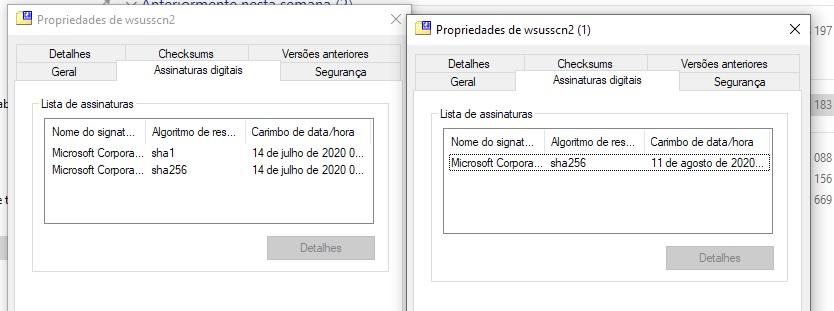Leaderboard
Popular Content
Showing content with the highest reputation on 08/13/2020 in Posts
-
I have a pertinent question... Why create a thread, when this topic is already being discussed: https://msfn.org/board/topic/181739-windows-update-error-code-80072efd/ https://msfn.org/board/topic/178377-on-decommissioning-of-update-servers-for-2000-xp-and-vista-as-of-july-2019/ Furthermore, you're linking to the Server 2008 update repository that I created without any kind of credit. Honestly, this thread seems pointless...2 points
-
After getting MSO 2010 SP2 installed recently, I found that there was no easy and intuitive way to get Office 2010 fully up to date. Even the latest cumulative updates on Microsoft's websites (and it's not at all obvious which ones are necessary, since the "latest" ones go back to September 2019 or even earlier) omit nearly 60 standalone updates that need to be downloaded separately. The goal here was to see if I could get Office updated from the get go w/o using Windows Update post-install. Starting with SP2*, this will get MSO 2010 fully up to date. This is for 32-bit Office 2010 Professional Plus (+Visio) on 64-bit Windows 7. (*This was starting with the install files for Office 2010 with SP2 already slipstreamed into the "Updates" folder, I don't think there's an official SP2 ISO anywhere). However, in Word and other Office applications, the version number does not change higher than 7243/7237 still, which is annoying since 7245 I believe is the February 2020 build #. But by "up to date", I mean when you run Windows Update, it will give you the green checkmark and say "No important updates available", woo hoo! The folders referenced below are where I have saved extracted copies of all the downloaded CAB updates, because obtaining them is a pain. The updates that are contained in each folder are provided below. Sadly, using Windows Update post-install is the only way to get the last 3 updates to install, to my knowledge. I tested pretty much every possible way. They cause problems if you try to install them manually. Anyways, hopefully this is helpful, it took hours of testing but using this procedure any vanilla Office 2010 SP2 can be brought fully up to date. PART I: 1. Copy "Office 2010 x86 Pro Plus VL with SP2" to local Desktop. This contains the latest cumulative updates. 2. Copy contents of "MSO 2010 Latest Standalone Updates" to the "Updates" folder contained in the folder on Desktop. Click "Keep both copies" when prompted in the Copy dialog. 3. Run setup.exe 4. Install Update for Visual Studio Tools for Office Runtime (2017) PART II: 1. Copy SW_DVD5_Visio_Premium_2010_W32_English_Std_Pro_Prem_MLF_X16-51030 with SP2 to local Desktop. 2. Copy contents of "MSO 2010 Latest Standalone Updates" to the "Updates" folder contained in the folder on Desktop. (Yes, this means all Office updates.) 3. Copy contents of "MSO 2010 Visio Latest Standalone Updates" to the "Updates" folder contained in the folder on Desktop. 4. Run setup.exe PART III: 1. Run Windows Update and install all IMPORTANT updates only. There should be (3) important updates. The steps above minimized the amount of updates Windows Update is needed for. The 3 important updates in Windows Update for MSO won't install manually (they still show up in WU), but if installed via Windows Update, they will disappear. *** UPDATES IN THE FOLDERS *** Latest Office 2010 Cumulative Updates: https://docs.microsoft.com/en-us/officeupdates/office-updates-msi UP TO DATE THROUGH 2020/02/21 FOR KB # RELEASED REPLACES Outlook 4484163 (2020/02/11) 4475573 (2019/08/13) Excel 4484267 (2020/02/11) 4484243 (2020/01/14) Office 4484236 (2020/02/11) 4484192 (2019/12/10) Office (Access) 4484193 (2019/12/10) 4484127 (2019/11/12) Office (Word) 4475598 (2019/12/10) 4475531 (2019/08/13) PowerPoint 4461613 (2019/12/10) 4461521 (2018/12/10) Word 4475601 (2019/12/10) 4475533 (2019/08/13) Office 4464566 (2019/09/10) 4462223 (2019/04/09) Project 4461631 (2019/09/10) 4022147 (2018/11/13) **NOT DOWNLOADED** --- Install these standalone x86 updates for MSO 2010 --- 3114416 3114414 2553154 2553313 2553332 2850016 2881029 2956063 3114565 3115120 3115197 3115248 3191908 4022206 4022208 3114872 2999465 4018363 3114879 2817369 2553092 2553140 2553347 2553388 2589298 2589375 2880971 2597087 2791057 2825640 2881030 3054886 3055047 3128031 4092436 4461579 4462187 3114559 2553308 2760601 3115314 4461626 982726 2956076 2589318 2589339 3054873 4462172 2883019 2589386 4011186 3115475 --- Install the applicable (e.g. language specific) component of these MSO 2010 x86 updates --- 4022136 2956084 4461625 3114885 2956076 3203468 3213626 3213631 --- Install the following updates during Visio install AS WELL (install all other updates above also) --- 4464566 4484193 2881025 (English only) *** END OF UPDATES TO SLIPSTREAM ** --- Duplicate CAB updates --- 3203468 3114885 --- Problematic updates --- 4011610: The upgrade patch cannot be installed by the Windows Installer service b/c the program to be upgraded may be missing or the upgrade patch may update a different version of the program. Verify that the program to be upgraded exists on your computer and that you have the correct upgrade patch.1 point
-
Finally got the time to create the much requested Update Repository for Vista. I've collected these updates a year ago, but only recently took the time to put them on my Mega account and organize them. It has roughly the same format as my post-EOL repositories, with x86 and amd64 versions. A few highlight points: Most updates come in ".cab" format, because at the time it was easier to manage bulk installations in this format (I was trying to update offline images) Includes hotfixes not distributed through Windows Update. These were collected through a mix of the now defunct MS Hotfix service and the website "hotfixshare". There's some interesting fixes in there. While most of the updates are language agnostic, some are specific to the language I use, Portuguese of Portugal (like the IE9 installer). If you'd like to provide a version for your language, please contact me. To install a ".cab" format update, just run the following command: start /w pkgmgr /ip /m:<path to updates> /s:<temp path for extraction> /l:<path for log files> /norestart To bulk install updates, I usually run the following set of commands: forfiles /p <path to update folder> /m *.cab /c "cmd /c mkdir @fname" forfiles /p <path to update folder> /m *.cab /c "cmd /c pkgmgr /ip /m:@file /s:@fname /norestart" The first command creates a folder for each individual update and the second one installs each update and extracts onto each created folder. Here's a practical example. Say, I have all of the updates from the repository located in my Downloads folder inside my user profile. In this case, I want to install every update in the "General" folder. I'd use the commands above like so: forfiles /p "C:\Users\greenhillmaniac\Downloads\General" /m *.cab /c "cmd /c mkdir @fname" forfiles /p "C:\Users\greenhillmaniac\Downloads\General" /m *.cab /c "cmd /c pkgmgr /ip /m:@file /s:@fname /norestart" I'd recommend you install no more than 200 updates at a time. This can also be used to create an updated Vista ISO for later use (tutorial coming soon™) Anyway, here's the link for the repository1 point
-
(Note: this text is written for and directed at Big Muscle. Just pointing it out in case that the "you"s looks a bit wierd to you (the person reading this text)) Let me first get the most important thing out of the way: You CAN make money with open source software. In many ways actually: You can charge for the convenicance of auto updates You can charge for direct support (for example, via email or via a private discord chat) You can charge for the convenicance of having an already compiled binary version (which is especially true on windows; on linux for example, you usually git clone the repo, cd into it and type `make && sudo make install` and that's it. On Windows though...) You can make (optional) donations Speaking of donations: what you offer on your website, those are NOT donations. Those are payments. It is NOT freeware. You just get a free demo version. A donation is something optional. The point of a donation is not to get something back from it (besides maybe the knowladge of having helped someone/-thing or maybe getting a "Thank you" mail from them), but purely to support someone/-thing. And I want to mention that that is the only reason why I actually paid 5 bucks for it: not because I care about the watermark (if that would be my only reason, I could have just used a cracked version, and yes, I DID have a working one back then, but I didn't use it), but because I want this project to stay alive. In other words: I am pretty shure that a lot of peole donated just for support, or at least partially. Anyways, I of course know that there are not only positive things about open sourceing this software, namely: You may not make the exact same amount of money from "donations"* You may unveal your secrets* However, both of these arguments are very weak. The first one I already talked about above. For the second one: opening this app would mean that a lot more developers could integrate it (as in making their app compatible with it, not as in stealing your code; the only app I know of that supports aero glass is Winstep Nexus, and that one only works when it really wants to, which, as a dev explained to me, is not their fault). It would allow other people to learn about windows from (because, as described on glass8.eu, it uses undocumented windows features). TL;DR both arguments are... bad. Now let's finally get to why I think it should be open sourced: You (Big Muscle) are not able to maintain this on your own, or at least not in a way that I would concider acceptable for a paid app. Often times, this app gets a fix about 1-2 months before the next major update comes out, which will break it again. And again. And again. This app would be accessable to a lot more people. It would improve the user experiance since it will allow updates to be completed much, much faster. You would not have to stem this project all on your own anymore, which, again, you're not able to. Almost the entire forum is just "It doesn't work" posts. As described previosly, third party compatibility could also be improved massively. A concern you may have is others missusing your code to make money on. This is actually not a problem. You can either use the GNU GPL (or similar), which will technically not prevent your code from being commericallized, but since every modification that is being made availably has to also be opensourced under the same license (or a newer version), it is very unrealistic to think that someone would actually do it, exept maybe in those ***** bundles. While some apps (like OpenOffice or 7-zip, see here ) do suffer from this problem, I, again, don't think that such a tool like AeroGlass would really suffer from this. Alternatively, you can also write your own license, for example like this (this is not legal advaise): Of course, the above mentiond "license" is only one of many ways it could be done (and, again, it is not legal advise). I hope that you will change your mind about this program and it's licensing and distribution, as it would gain both you and even more so it's community. Cheers.1 point
-
I used three ways together: Usual Appearance control panel to select a classic theme + "ThemeActive"="0" + Tweak UI to copy over some colors to the login. Result is that I don't see any remainder of Luna XP theme anywhere. Neither do I see any default color scheme colors; using blue-grey myself as I find the white and light-grey too bright for my comfort. So AFAIK everything is customized.1 point
-
I have been seeing this issue with Windows XP updates since August 10. I tried to update the system via WUMT and I was getting error 0x80072F8F. However, in offline mode, it finds updates via the TigTex .cab file...1 point
-
Inkscape 1.0 (May build) working here. I grabbed the 7z archive rather than the installer package though, so it just runs from a local folder. No other workarounds necessary. Just runs1 point
-
1 point
-
That 7zip component simply calculates the checksums for the executable. It does not check for any digital signatures tied to it. My Windows 2000 does in fact allow me to check for digital signatures/certificates via file properties in Explorer. So XP should as well. I just checked a Vista update from this year. Click the Digital Signatures tab, then click "Details", and then "Advanced" tab. Under "digest algorithm", it says sha256.1 point
-
I’m actually rather dissatisfied with that decommissioning thread, e.g. about half of recent discussion revolves around the desire of Dave-H to get the last Office 2010 updates for his fully-updated XP system without resorting to the catalog (never mind that Dave-H has a separate thread about Office 2010 updates.) For those who are attempting to update after a clean install, that thread might not be particularly helpful overall.1 point
-
I sure do miss my window borders. Don't get me wrong, I love translucency, but to me the biggest improvement I've felt from Big Muscle's software is to be able to create compositing resources that include a visible border. There is no substitute for visually finding the window border for resizing, etc. I can't tell you how many times I've been frustrated by trying to grab the corner, no, inside the corner, no just outside the corner, only to have a window underneath jump up unexpectedly or something. -Noel1 point
-
@Dave-H and @Dylan Cruz I've fixed it! Found an easy way to fix Office 2010 and not break TLS updates. Get KB3081320 from WU Catalog, extract it and copy dssenh.dll to C:\Program Files\Microsoft Office\Office14. That's it.1 point
-
Big thanks to @daniel_k for discovering this method. Tools you'll need: A copy of Windows 8 Embedded Standard (MS is gracious enough to provide us with a download link: https://www.microsoft.com/en-us/download/details.aspx?id=37019) 7-Zip to make it easier to copy files from inside the install.wim This tutorial applies to both AMD64 and X86. Download all 3 parts of Standard_8_64Bit_Bootable_IBW if using 64 bit, or all 2 parts if using 32 bits, and open part 1 to extract the ISO. After this you should have Standard_8_64Bit_Bootable_IBW.iso or Standard_8_32Bit_Bootable_IBW.iso Open the ISO with 7-Zip and navigate to "sources/install.wim". Right click on the install.wim and select "Open inside". Inside the install.wim, go to "Windows/servicing/Packages" Here's where it differs for both architectures. For 64 bit copy the following files into a folder in your computer: For 32 bit copy the following files: Next go to "Windows/winsxs/Manifests" and... For 64 bit copy these files into the same folder you extracted the previous ones: For 32 bit copy these files: Now here's the interesting part. Open command prompt with Admin privileges and run: If using 64 bit: dism /online /add-package /packagepath:<path to folder>\Microsoft-Windows-Embedded-SKU-Foundation-Package~31bf3856ad364e35~amd64~~6.2.9200.16384.mum If using 32 bit: dism /online /add-package /packagepath:<path to folder>\Microsoft-Windows-Embedded-SKU-Foundation-Package~31bf3856ad364e35~x86~~6.2.9200.16384.mum Reboot and install IE11 like you normally would. This time it will finish the installation and prompt you to reboot. After that, IE11 will be fully operational on your machine! Here's some pics of the results:1 point
-
@bigmuscle Yes, please consider this for the future development of Aero Glass. If you want to keep it paid, at least provide a bit more communication.1 point
-
And on Windows XP Serpent can open https://tls13.1d.pw/ too saying: "Successfully connected TLS 1.3 OK;" Unbelievable!1 point






